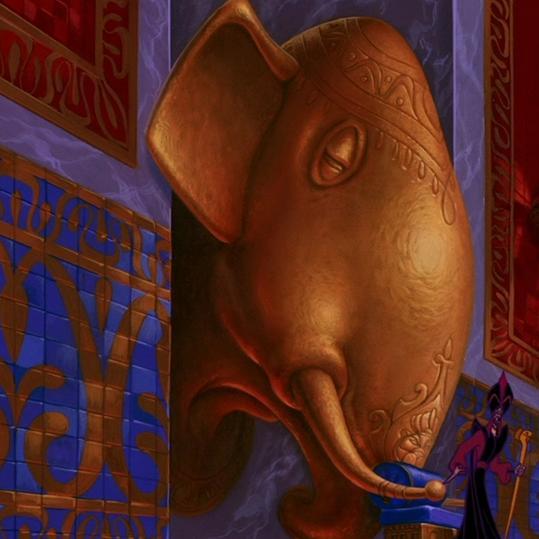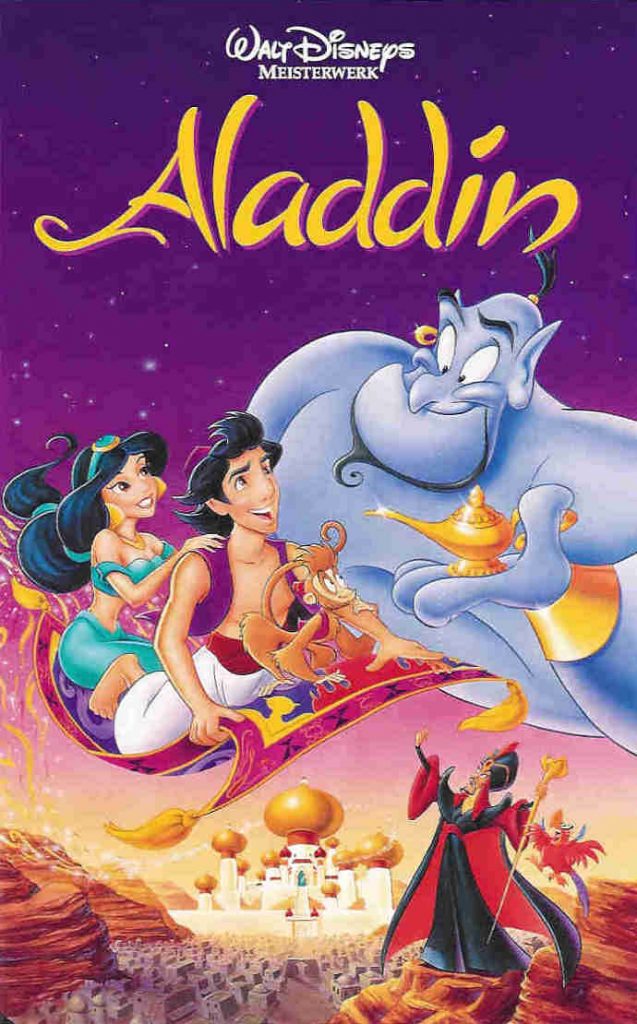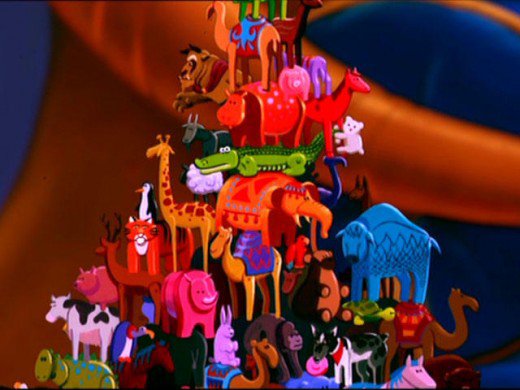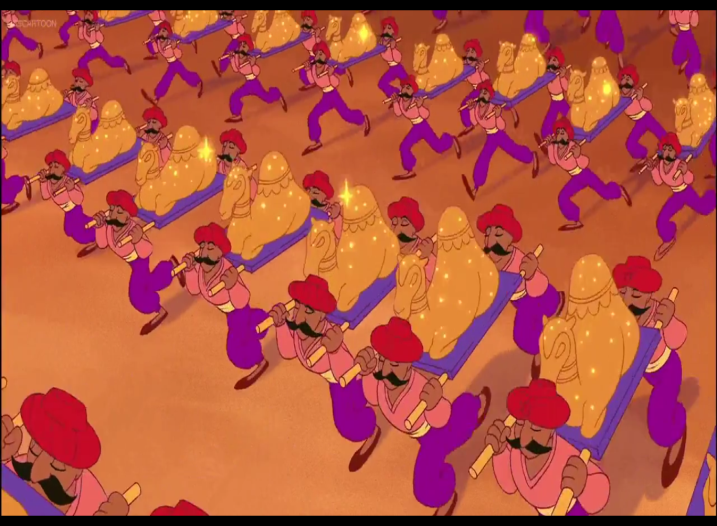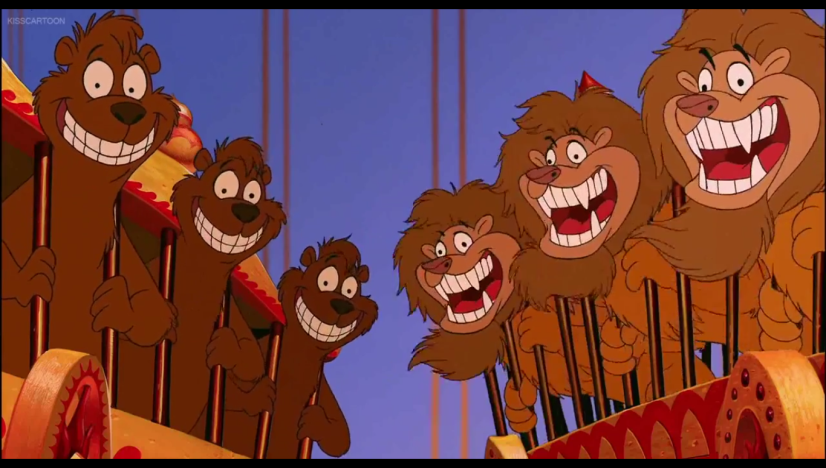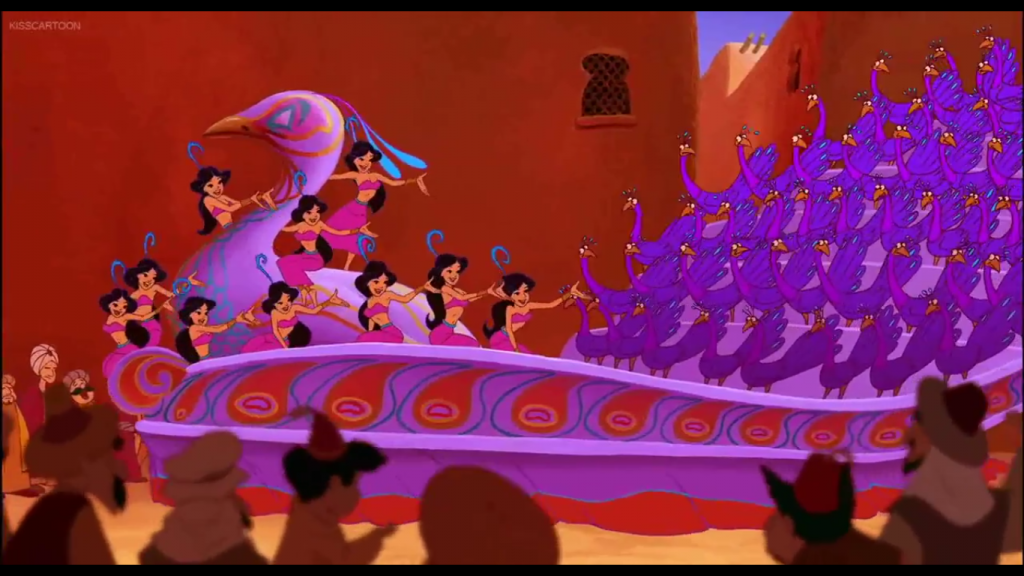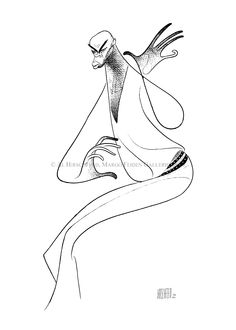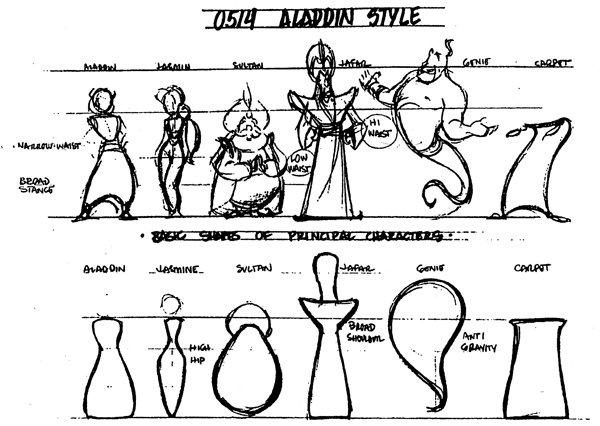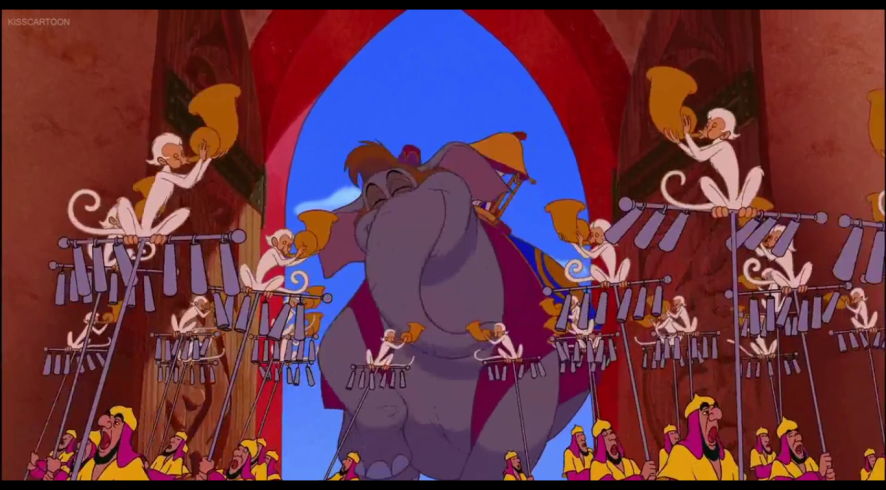Ron Clements’ and John Muskers’, Aladdin (1992) [1] follows the life of a poor street dweller and his sidekick monkey, Abu in the fictional city of Agrabah. After being coerced into entering the subterranean ‘cave of wonders’ by the villain Jafar and his accomplice parrot, Iago, Aladdin retrieves a magic lamp containing a genie. With the help of the genie, Aladdin escapes the cave and attempts to win over the princess Jasmine disguised as a prince. He dazzles the city with his newfound fortune consisting of sacks of gold and a vast array of exotic animals. The film is brimming with animal presence as the genie brags of Aladdin’s ‘world class menagerie’, whilst the palace is packed with animal décor such as the golden elephant throne. However, Jafar’s scheming exposes Aladdin, thus reducing him to his previous ‘street rat’ status. Aladdin nonetheless, outsmarts Jafar, proving his worth, consequently winning the heart of the princess.
Aladdin is an animated musical fantasy film based round the Arab folktale, Aladdin and the Magic Lamp from the collection of Middle Eastern stories, One Thousand and One Nights. Part of the ‘Disney Renaissance’ (a creative revival of Disney films from 1989-1999) Aladdin was the most successful film of 1992 earning over $504mil in revenue worldwide. It incorporates several film genres such as: fantasy, comedy, musical and adventure, maintaining appealing aspects to both parents and children alike. Prominently, a common theme that unites all of these genres is animals.
Fantasy:
Aimed at the primary target audience, ‘the little ones’ [2], the theme of magic and dreams (along with talking pets) is enough to captivate any child movie-goer (and some adults too).
Comedy:
A key component to the comedic nature of the film stems from the animal sidekicks. Whether it’s the ‘the scene stealing monkey Abu’ [3] or the volatile and explosive Iago, each act as comedy relief from the tragic circumstances their human companions often find themselves in. However, the humour is often rooted in violence towards the animals, such as Jafar’s mistreatment of Iago, setting up questionable moral implications about the treatment of animals.
Musical:
The musical element transforms Aladdin into an ‘event movie’ [4] as the grandiose scale of ‘Prince Ali’ demonstrates Disney’s attempts to wow audiences as Aladdin intends to wow Princess Jasmine. A vital element in showcasing this spectacle is through the use of exotic animals. Appearing as symbols of luxury, the genie boasts of Aladdin’s ‘75 golden camels, 53 purple peacocks, 60 elephants, and llama’s galore’, idolising them and arguably placing them on a higher social position than women.
Adventure:
Throughout the film, the concept of exploring a ‘whole new world’ is enticing. This adventure and exoticism that the protagonists yearn for is largely presented through the array of unusual animals. Yet the difference in treatment of these animals, for instance, the celebrated white Persian monkeys in comparison to Abu, a common brown ape, opens up broader issues of racism amongst both humans and animals.
Prominently, the film presents animals as sidekicks or assistants to their human companions. Often being referred to as ‘friends’, animals such as Abu, Raja and Iago are elevated from a subordinate animal status to a slightly more equal station to humans. Pick argues that ‘an animal’s life… can be seen to run parallel to his’ (man’s). ‘With their parallel lives, animals offer man companionship which is different from any offered human exchange. Different because it is a companionship offered to the loneliest of man as a species’. [5] The suggestion that the animals’ lives mirror those of their human companions maintains their status as equals as they live the same lifestyles, such as Abu and Aladdin’s mutual existence. This is intensified as although they appear to exist solely to cure the loneliness of man, for instance, Abu is the family Aladdin lacks, the notion that their companionship is ‘different from an offered human exchange’ elevates the animal once again for their unique ability to offer a camaraderie that humans cannot. This therefore restores the hierarchical equilibrium.
This parallelism of humans and animals implies that animals are extensions or manifestations of the humans themselves. For instance, Jasmine, a fiery and rebellious character that battles against her father’s wishes for an arranged marriage, is suitably represented through her animal companion Raja, the fierce yet loving tiger. Whereas Jafar, a manipulative and secretive vizier is seconded by his parrot assistant Iago. Named after a Shakespearian villain known for his cunning nature, Iago puts forth a vacant and dim exterior that merely squawks and repeats. Yet in reality he is intelligent, cloaking his ability to speak and communicate, much like Jafar’s façade as the dutiful royal vizier to the sultan. And last but not least, Aladdin’s mischievous kleptomaniac monkey, Abu. Abu represents his cheeky, animalistic side such as his animal desires for food and riches. He is consistently stealing and even shown licking his lips as the promise of rubies, Abu is therefore symbolic of Aladdin’s animal self. This ideas that the animals are extensions of the self, ties in with the fantasy genre as these hyperbolic cinematic representations of animals, such as their heightened anthropomorphic tendencies raise questions ‘to the point at which fiction and reality collapse into one another’ [6], implying that these are imagined representations of animals.
However the human/animal equilibrium is challenged as the majority of animals within the film are exhibited as objects of luxury and wealth. For instance, the palace is stocked with animal décor such as the elephant throne and tiger patterned rugs. The sultan is even seen physically playing with toy animals at his free will, piling them up and knocking them down, demonstrating his ultimate power over them. Furthermore, in the song ‘Prince Ali’, the genie lists the endless ‘exotic type mammals’ Aladdin owns, unveiling his wealth and presenting them as precious commodities rather than conscious beings. Although it may appear that they are being worshipped above humans, ultimately the humans’ ownership over them preserves them as material objects. This is explicitly shown with the ’75 golden camels’ as they are functionless objects merely used as material signifiers of wealth. Likewise, the live animals themselves are used within this grand circus act to demonstrate Aladdin’s affluence. Made to perform wielding golden trumpets and forcing sickening grins from behind bars, they are reduced to a subservient role.
This strange idolization of exotic animals could also be said for women. Both women and animals are seen as something to be owned. During Aladdin’s negotiations with Jafar and the sultan, he states ‘I will win your daughter’. Outraged, Jasmine retorts ‘I am not a prize to be won!’ This concept of ownership over women demonstrates the male view of women’s place in society, alongside animals as objects rather than sentient beings. Jafar emphasizes this later as he states ‘you’re speechless I see, a fine quality in a wife’, exposing the visual emphasis on women that is similarly placed on animals. Jasmine is even referred to as a ‘street mouse’ by a palace guard, again placing her on the same level as an animal.
This notion of animals appearing socially above women is also suggested as the male animals, such as Iago and Abu appear as ‘accomplices’ or ‘esteemed offendee’s’ as opposed to ‘prizes’. They negotiate with their male human companions, work together, and regularly save them from unfortunate circumstances, overall implying a higher regard for them over women.
Occasionally however, this veneration of animals means that they supersede women within this hierarchy of power. This is visually implied during Aladdin’s entrance to the palace with the peacock float. The blocking of the characters physically presents this hierarchy as the women are lower than the animals. This is emphasised by the costumes as it suggests that women are to be valued merely for their sexuality. They are seen in miniscule outfits bearing their midriffs or sensually dancing with scarves, outwardly showcasing their ‘most important’ value.
Yet, despite this interchanging social status of women and animals, both are presented as ultimately inferior to man. The animals are constantly belittled and frequently met with violence. Often a source for comedy, Jafar’s mistreatment of Iago demonstrates his abuse of authority as he constantly strikes him. This creates questionable undertones as the animals’ anthropomorphism shows their capacity for emotion, and thus makes this more saddening. For instance, Iago’s frequent joking ‘that’s sultan vile betrayer to you!’, their abilities to do impressions of each other, along with Raja’s tears as Jasmine tries to leave the palace, all demonstrate relatable human characteristics that allows the viewer to become more aware of their suffering. This tactic of violence against animals for the sake of comedy, to me is problematic, despite the animated genre meaning their injuries are never long lasting; it sets a damaging example for the younger viewers on the treatment of animals.
Similarly, along with the violence against animals potentially creating controversy, another source of dispute is presented by the misrepresentation of Arabs. Many critics complained that ‘most Arab characters have exaggerated facial characteristics- hooked noses, glowering brows and thick lips, whilst the protagonists look like white American teenagers’.[7] Furthermore, the opening musical number ‘Arabian Nights’ was altered due to protests from the ‘American-Arab Anti-Discrimination Committee’ (ADC) and the lyrics were changed in 1993 from ‘where they cut off your ear if they don’t like your face’ to ‘where it’s flat and immense and the heat is intense’ owing to the racist implications. However, in defence of the film’s animators, their characters ‘exaggerated features’ were supposedly allusions to Al Hirschfeld’s drawings, widely known for their overstated features.
This racial controversy also extends amongst animals and species. For example, Abu, a small brown haired scruffy looking monkey is branded a ‘filthy ape’, whereas the ‘95 white Persian monkeys’ are celebrated and paraded through the streets of Agrabah as objects of wealth, as the palace guards call out ‘he’s got the monkey’s, let’s see the monkeys!’, despite their city teaming with brown monkey’s. This opens up broader questions about race about the celebration of whiteness over everything else.
To summarise, animals are represented as objects to be used as features for our entertainment. The animals appear to live a slavish existence as they provide for the dependent man. ‘Men depend upon animals for food, work, transport and clothing’. [7] Camels, elephants and horses are used throughout the film as transport as cooked chickens are piled high upon the characters’ plates. This dependence on animals is also represented through the beetle jewel at the beginning of the film as the animal holds the knowledge of the whereabouts of the cave of wonders, which Jafar needs to find the lamp.
Animals in the film are also presented as symbols which provide an insight into the minds of the characters. For instance, Jasmine releases a cage full of birds just as she is expressing her desire to escape the palace walls. The birds therefore represent freedom and Jasmines desire to obtain it. Another instance is through Jafar’s snake staff as this reflects his sly and cunning nature. And lastly, Aladdin is seen running on top of a herd of sheep. As sheep are often associated with unoriginality this serves to emphasise how he stands out and is not simply a part of the crowd, but a ‘diamond in the rough’.
Overall, although the hierarchy of humans and animals within this film appears to fluctuate dramatically, ultimately man remains superior to the animal. The animal is a helping hand or a symbol of wealth and luxury, rather than an independent being with their own agency. The animal presence within this film appears innocent and light hearted, perhaps a front that is encouraged by the children’s genre, however upon deeper inspection, animal presence opens up broader issues such as the treatment of women, racism and violence towards animals. Ultimately though, Musker‘s and Clements’ musical comedy is a highly successful children’s film, despite certain controversies surrounding it.
[1] Aladdin. Dir. Ron Clements and John Musker. Disney. 1992.
[2] Steve Daly, ‘Disney’s Got a Brand-New Baghdad’, Entertainment Weekly, 4 December 1992, p. 1.
[3] Janet Maslin, ‘Disney Puts Its Magic Touch on ‘Aladdin’, The New York Times, 11 November 1992, p. 1.
[4] Steve Daly, ‘Disney’s Got a Brand-New Baghdad’, Entertainment Weekly, 4 December 1992, p. 2.
[5] Anat Pick, Creaturely Poetics: Animality and Vulnerability in Literature and Film, (USA: Columbia University Press, 2011) p. 6.
[6] Ibid., p. 109.
Bibliography
Primary Sources
Pick, Anat, Creaturely Poetics: Animality and Vulnerability in Literature and Film, (USA: Columbia University Press, 2011)
Berger, John, Why Look at Animals? (London: Penguin, 2009)
Haydock, Nickolas, Risden, E. L., Hollywood in the Holy Land : Essays on Film Depictions of the Crusades and Christian-Muslim Clashes (New York: McFarland, 2009)
Secondary Sources
Maslin, Janet, ‘Disney Puts Its Magic Touch on ‘Aladdin’, The New York Times, 11 November 1992
Steve Daly, ‘Disney’s Got a Brand-New Baghdad’, Entertainment Weekly, 4 December 1992
Filmography
Clements, Ron, Musker, John, Aladdin Disney (USA 1992)
